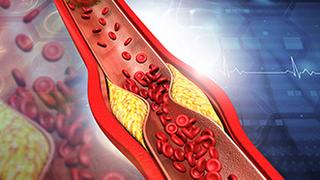
LDL is bad because it leads to a buildup of cholesterol in our arteries, which can lead to plaque build-ups and potentially cause blockages, which can eventually cause a heart attack or a stroke. Image used for representational purposes only
| Photo Credit: Getty Images
Changing lifestyle patterns have given rise to a host of non-communicable diseases (NCDs) in India, including diabetes, hypertension and dyslipidemia. A recent cross-sectional study conducted by the Indian Council of Medical Research–India Diabetes (ICMR-INDIAB), assessed a representative sample of individuals aged 20 years and older, drawn from urban and rural areas of 31 States, Union Territories, and the National Capital Territory of India found that dyslipidemia was prevalent in 81.2 % of the total of 1,13,043 individuals (79,506 from rural areas and 33,537 from urban areas) who participated in the survey.
This presents a worrying scenario, one where individuals as young as 20 are already showing signs of abnormal lipid profiles, significantly increasing their risk of developing heart disease and other complications later in life. If left unchecked, this can snowball into a major public health challenge for our country.
Understanding dyslipidemia
To understand dyslipidemia, we need to understand what cholesterol is. Cholesterol is a fat-like substance found in all cells of our body. Cholesterol travels through the body in small packages called lipoproteins. Lipoproteins are of three types: LDL or low-density lipoprotein known as ‘bad cholesterol’, HDL or high-density lipoprotein known as ‘good cholesterol’, and triglycerides.
LDL is bad because it leads to a buildup of cholesterol in our arteries, which can lead to plaque build-ups and potentially cause blockages, which can eventually cause a heart attack or a stroke. HDL or high-density lipoprotein is good for the body because it carries cholesterol from other parts of the body back to the liver which removes the cholesterol from the blood. Triglycerides are also bad for the body; they are a type of fat stored in your body and used for energy. They increase when you consume more calories (especially sugar and fat) than your body needs. High triglyceride levels can contribute to hardening or thickening of the arteries, increasing the risk of stroke, heart attack, and pancreatitis.
To check for dyslipidemia, all three types of lipids are tested: if LDL and triglycerides are more than 100 mg/dl and 150 mg/dl respectively and HDL is lower than 40 mg/dl in men and 50 mg/dl in women, it means your body has high cholesterol levels that need to be brought under control.

The South Asian problem
The South Asian population in general, is more prone to NCDs such as dyslipidemia and diabetes due to a genetic risk, lack of physical activity, and suboptimal dietary habits. Our population tends to have low HDL (good cholesterol) levels, which puts it at a markedly increased risk for heart disease.
HDL is even more important than LDL. Low HDL is three times more common than high LDL in patients with premature heart disease. Thus, there is an urgent need to lower LDL levels and increase HDL levels to protect the heart from diseases, and the best way to do this is through a good diet and active lifestyle. Those with dyslipidemia and increased LDL levels (bad cholesterol) should restrict saturated fat to less than 7% of their total calorie count and cholesterol intake to less than 200 mg/day. They should add more fibre through dietary strategies such as increasing oats or psyllium, as well as fruits and vegetables. This can help decrease bad cholesterol. Indian foods such as rice, puri, naan, white bread and fried items are all high in non-saturated fats and can hike triglyceride levels.

Combating obesity
Obesity is strongly linked to dyslipidemia and weight management is an essential part of the recovery plan to lower lipid levels. Physical exercise for at least 45 minutes a day, five days a week is a must. For those who are not able to control their cholesterol levels with lifestyle changes such as diet and exercise, effective prescription medications are available and should be strictly adhered to.
Discipline can help us avert a health crisis at the national level.
(Dr. S. Sadhanandham is consultant & interventional cardiologist, professor – cardiology, Sri Ramachandra Institute of Higher Education and Research, Chennai. cardiosadha@rediffmail.com)
Published – July 19, 2025 01:23 pm IST















Leave a Reply